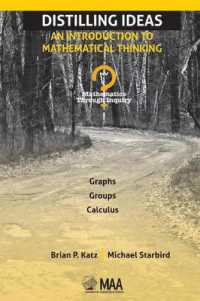Full Description
Mary Shelley's Mathilda, the story of one woman's existential struggle after learning of her father's desire for her, has been identified as Shelley's most important work after Frankenstein. The two texts share many characteristics, besides authorship and contemporaneity: both concern parental abandonment; both contribute to the Gothic form through themes of incest, insanity, suicidality, monstrosity, and isolation; and both are epistolary. However, Mathilda was not published until 1959, 140 years after Shelley wrote it—in part because Shelley's father, William Godwin, suppressed it. This new edition encourages a critical reconsideration of a novella that has been critically stereotyped as biographical and explores its importance to the Romantic debate about suicide.
Historical appendices trace the connections between Mathilda and other works by Shelley and by her mother, Mary Wollstonecraft, while also providing biographical documents, contemporary works on the theme of incest, and documents on suicide in the Romantic era.
For Michelle Faubert's transcription of Mathilda for the Shelley-Godwin Archive, click here.
Contents
Awknowledgements
Introduction
Mary Shelley: A Brief Chronology
A Note on the Text
Mathilda
Appendix A: The Romantic-era Suicide Debate
From William Godwin's An Enquiry Concerning Political Justice, and Its Influence on General Virtue and Happiness (1793)
From David Hume's Essays on Suicide and the Immortality of the Soul (1793)
From William Rowley's A Treatise on Female, Nervous, Hysterical ... Diseases (1788)
From John Francis' "Sermon III. On Self-Murder" (1749)
From Johann Wolfgang von Goethe's The Sorrows of Young Werther (1774)
From Lord Byron's Manfred (1817)
William Wordsworth's "The Complaint of a Forsaken Indian Woman" (1798)
Appendix B: Family Resemblances
Full-detail transcription from Mary Shelley's manuscript of "Mathilda" (1819)
From Mary Shelley's "The Fields of Fancy" (1819)
From Mary Shelley's "The Mourner" (1830)
From Mary Shelley's Frankenstein (1818)
From Mary Wollstonecraft's Mary, A Fiction (1788)
From Mary Wollstonecraft's The Wrongs of Woman, or Maria (1798)
From Mary Wollstonecraft's "Cave of Fancy" (composed 1787; published 1798)
Appendix C: Incest, the Gothic, Literary Forebears
From Percy Bysshe Shelley's The Cenci (1819)
From Percy Bysshe Shelley's Laon and Cythna (1818)
From Vittorio Alfieri's Myrrha (1815)
From Matthew Lewis' The Monk (1796)
From Horace Walpole's The Castle of Otranto (1764)
Appendix D: Biographical Context: Shelley's Letters and Journals
Letter from Godwin to P. B. Shelley on Fanny Imlay's suicide (1816)
From Harriet Shelley's suicide letter (1816)
Letter by Mary Shelley on William Shelley's final illness (1819)
William Godwin's letter to Mary Shelley on her son's death (1819)








